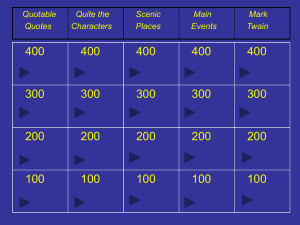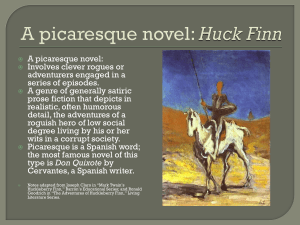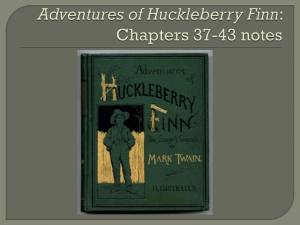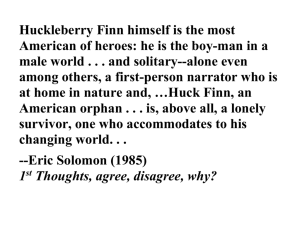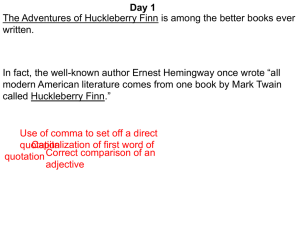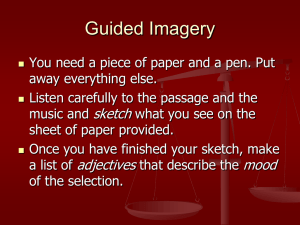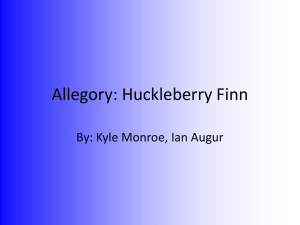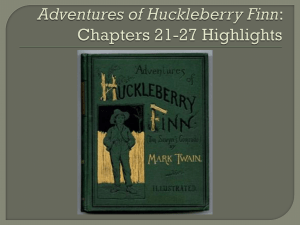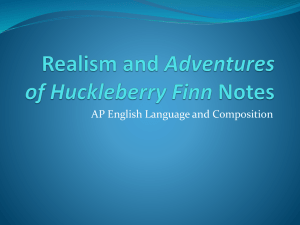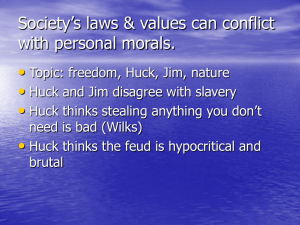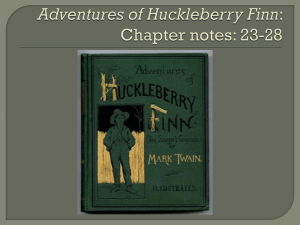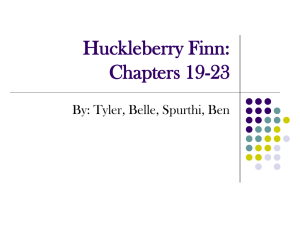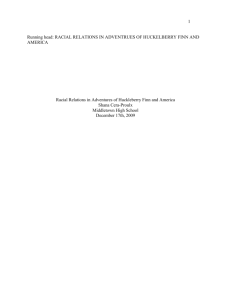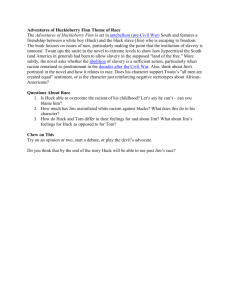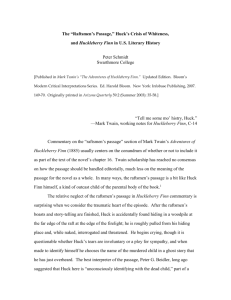Huck Finn PowerPoint
advertisement
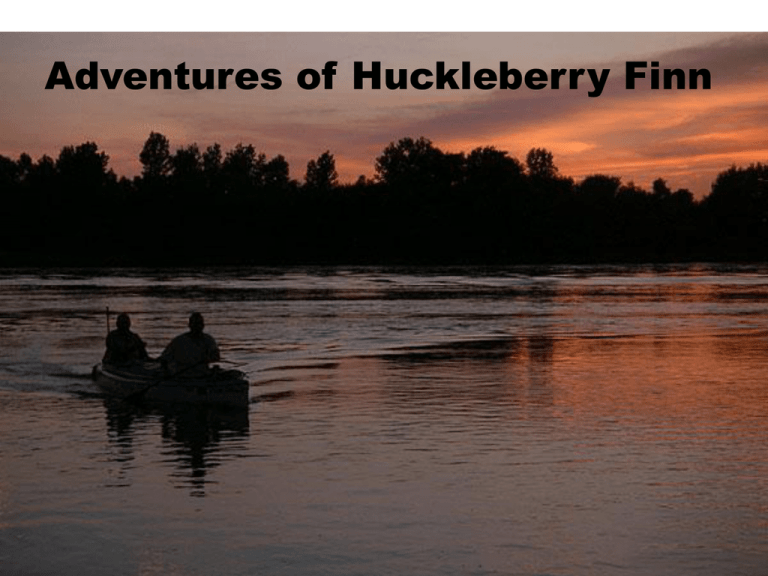
Adventures of Huckleberry Finn Notice Persons attempting to find a motive in this narrative will be prosecuted; persons attempting to find a moral in it will be banished; persons attempting to find a plot in it will be shot. By Order of the Author Per G.G., Chief of Ordnance Twain defined a classic as “a book which people praise and don’t read.” Adventures of Huckleberry Finn has always been popular with readers; at the same time it has had many critics attempt to censor it. Picaresque Novel The picaresque novel was introduced as a genre of fiction in 18th c. Spain. It is usually satirical and depicts, in realistic and often humorous detail, the adventures of a roguish hero of low social class who lives by his wits in a corrupt society. The Picaro Picaro means rogue or rascal. He is the antithesis of the medieval hero. While a Knight… Was of noble birth, from a worthy, mighty family. The Picaro’s background was low and immoral. A knight’s adventure While a knight went on quest for something admirable, A Picaro’s adventures often involved escaping from the law. While a Knight embodies Virtue, superhuman strength and ideal values… The Picaro is often physically weak and survives through deception, stealth and theft. Episodic Plot The book was written over a number of years. Twain started it in 1876 and finished it in 1883. It was originally intended as a number of episodes that satirized faults of American society. To the River, Against Slavery Originally Twain thought that Huck would flee Pap’s cabin and encounter a number of adventures across land. But Twain knew and loved the river and so he set Huck afloat. When Huck discovers Jim on Jackson’s Island, he has a companion and a new focus. FREEDOM? The plot switches to helping Jim obtain freedom. Jim and Huck float SOUTH. An escaped slave should head NORTH. Supposedly the two will book steamboat passage at Cairo, BUT… There’s one little problem. What to do next? Twain wanted to write about life in the South along the river – he did not really want to send his characters north and write about unfamiliar territory. Therefore, he got stuck in the middle and abandoned the book for some years. Twain’s “I’ve Got It” Moment He eventually solved this problem by introducing the King and the Duke and having them kidnap Huck and Jim, forcing them to continue South. “Read receptively, but also read Resistantly.” -- Edward Said (Palestinian-American Literary Theorist) Reading Receptively… We can appreciate the portrayal of Jim as a loving, caring parent. The father-son relationship that develops between Huck and Jim is in stark contrast to Huck’s own father. Huck is the true innocent and divine fool. He sees the truth about society. His “death” at the start of the book is a kind of burying of his past and conventions. Huck’s transformation Huck gradually comes to see Jim as a real person, not as a stereotypical slave. First is Jim’s remorse over tricking Jim about being separated in the fog: “It was 15 minutes before I could work myself up to go and humble myself to a n…-but I done it, and I warn’t ever sorry for it afterwards, neither.” Climax of the Novel In chapter 31, after Huck writes a letter telling the widow where to find Jim he says to himself: “’All right then, I’ll go to hell’” –and tore it up.” River as a Third Character “What you want, above all things, on a raft, is for everybody to be satisfied, and feel right and kind towards others.” Contrast to Town The peace and harmony on the river is in contrast to the rapscallions Huck meets on shore: • the Grangerfords and Sheperdsons • Col. Sherburn and others. • The King and the Duke Reading Resistantly… The question, “Should Huckleberry Finn be banned?” was first posed in 1885 – the year the book about an interracial friendship was first published. “Anti-hero” of the Nursery -Members of the Public Library of Concord, Massachusetts banned the book because it was "rough, coarse and inelegant, dealing with a series of experiences not elevating, the whole book being more suited to the slums than to intelligent, respectable people." The troubling N-Word The word “nigger” is used over 200 times in the book. A derogatory term when Twain wrote the book, the word is even less acceptable today. Taught in High Schools? During the 1990’s it was one of the most frequently challenged books, primarily because of its language. Aspects of a Minstrel Show The minstrel show was an American entertainment consisting of comic skits, variety acts, dancing, and music, performed by white people in blackface. Jim as a Minstrel Character Minstrel shows lampooned black people as ignorant, lazy, buffoonish, superstitious, joyous, and musical. Do scenes—such as those with the king and Duke – portray Jim in this light? Book Illustrations also suspect Famous Hemingway Quote “All modern American literature comes from one book by Mark Twain called Huckleberry Finn…It’s the best book we’ve had. All American writing comes from that. There was nothing before. There has been nothing as good since.” What did Hemmingway leave out? What is in the ellipses? The Ending with Tom Sawyer “If you read it you must stop where the Nigger Jim is stolen from the boys. That is the real ending.” Indeed, many find the foolishness of Tom nearly unbearable. Once again, Jim’s humanity is denied and Huck falls under Tom’s spell. The Last Words “But I reckon I got to light out for the Territory ahead of the rest, because Aunt Sally she’s going to adopt me and sivilize me and I can’t stand it. I been there before.” Myth of the West Like Holden Caulfield, Huck cannot find any good in society and cannot abide by its rules. Unlike Holden who is hospitalized, Huck can set out on another adventure – seeking freedom from rules and an escape from hypocrisy.
